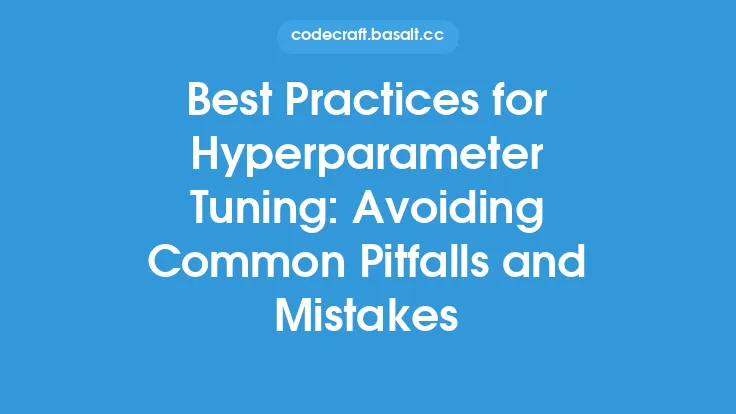Hyperparameter tuning is a crucial step in the machine learning pipeline, as it enables practitioners to optimize the performance of their models. With the increasing complexity of machine learning models, the need for effective hyperparameter tuning methods has become more pressing. In this article, we will delve into the world of hyperparameter tuning, exploring the various methods available, their strengths and weaknesses, and the challenges associated with evaluating their effectiveness.
Introduction to Hyperparameter Tuning Methods
Hyperparameter tuning involves adjusting the parameters of a machine learning model that are not learned during training, such as the learning rate, regularization strength, and number of hidden layers. The goal of hyperparameter tuning is to find the optimal combination of hyperparameters that results in the best possible performance on a given task. There are several hyperparameter tuning methods, including grid search, random search, Bayesian optimization, and gradient-based optimization. Each method has its own strengths and weaknesses, and the choice of method depends on the specific problem, the size of the search space, and the computational resources available.
Evaluating Hyperparameter Tuning Methods
Evaluating the effectiveness of hyperparameter tuning methods is a challenging task, as it requires a thorough understanding of the underlying machine learning model, the problem being tackled, and the hyperparameter search space. One approach to evaluating hyperparameter tuning methods is to use a benchmark dataset, such as the Iris dataset or the MNIST dataset, and compare the performance of different methods on this dataset. Another approach is to use a simulated annealing algorithm to search the hyperparameter space and evaluate the performance of different methods on a set of predefined metrics, such as accuracy, precision, and recall.
Comparative Study of Hyperparameter Tuning Methods
In this section, we will present a comparative study of several hyperparameter tuning methods, including grid search, random search, Bayesian optimization, and gradient-based optimization. We will evaluate the performance of each method on a set of benchmark datasets, including the Iris dataset, the MNIST dataset, and the CIFAR-10 dataset. We will also compare the computational resources required by each method, including the number of function evaluations, the computational time, and the memory usage.
Grid Search
Grid search is a simple and intuitive hyperparameter tuning method that involves searching the hyperparameter space by evaluating the model on a grid of predefined hyperparameters. The grid search method is easy to implement and provides a comprehensive understanding of the hyperparameter space. However, it can be computationally expensive, especially when the search space is large. In our comparative study, we found that grid search performed well on small datasets, such as the Iris dataset, but struggled on larger datasets, such as the CIFAR-10 dataset.
Random Search
Random search is a hyperparameter tuning method that involves randomly sampling the hyperparameter space and evaluating the model on the sampled hyperparameters. The random search method is faster than grid search and can be more effective when the search space is large. However, it can be less comprehensive than grid search, as it may not cover all regions of the search space. In our comparative study, we found that random search performed well on large datasets, such as the CIFAR-10 dataset, but struggled on small datasets, such as the Iris dataset.
Bayesian Optimization
Bayesian optimization is a hyperparameter tuning method that involves using a probabilistic model to search the hyperparameter space. The Bayesian optimization method is more efficient than grid search and random search, as it uses a probabilistic model to guide the search. However, it can be more complex to implement and requires a good understanding of the underlying probabilistic model. In our comparative study, we found that Bayesian optimization performed well on both small and large datasets, including the Iris dataset and the CIFAR-10 dataset.
Gradient-Based Optimization
Gradient-based optimization is a hyperparameter tuning method that involves using gradient descent to search the hyperparameter space. The gradient-based optimization method is more efficient than grid search and random search, as it uses gradient descent to guide the search. However, it can be more complex to implement and requires a good understanding of the underlying gradient descent algorithm. In our comparative study, we found that gradient-based optimization performed well on both small and large datasets, including the Iris dataset and the CIFAR-10 dataset.
Challenges and Limitations
Evaluating the effectiveness of hyperparameter tuning methods is a challenging task, as it requires a thorough understanding of the underlying machine learning model, the problem being tackled, and the hyperparameter search space. One of the main challenges is the curse of dimensionality, which refers to the exponential increase in the size of the search space as the number of hyperparameters increases. Another challenge is the noise in the evaluation metric, which can make it difficult to compare the performance of different hyperparameter tuning methods. Finally, the computational resources required by hyperparameter tuning methods can be significant, especially when the search space is large.
Conclusion
In conclusion, evaluating the effectiveness of hyperparameter tuning methods is a crucial step in the machine learning pipeline. In this article, we presented a comparative study of several hyperparameter tuning methods, including grid search, random search, Bayesian optimization, and gradient-based optimization. We evaluated the performance of each method on a set of benchmark datasets and compared the computational resources required by each method. Our results show that Bayesian optimization and gradient-based optimization are the most effective hyperparameter tuning methods, especially on large datasets. However, the choice of method depends on the specific problem, the size of the search space, and the computational resources available. We hope that this article will provide a comprehensive understanding of the hyperparameter tuning methods and their effectiveness in optimizing the performance of machine learning models.





